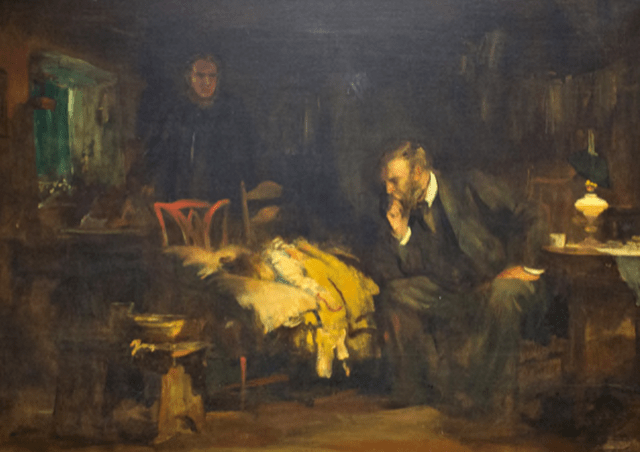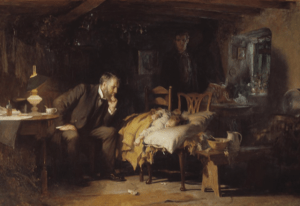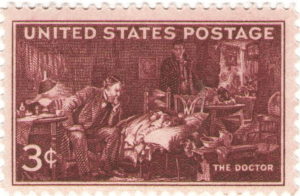If the picture in today’s header seems oddly familiar, you are right. It is a precursor image of the famous picture, “The Doctor” that hangs in the Tate Gallery in London and was painted by the imminent nineteenth century British artist, Sir Luke Fildes.
The story behind the picture is described in the first link. I have added the bolding to emphasize points to follow.
In 1890 Sir Henry Tate (1819-98) commissioned a painting from Luke Fildes, the subject of which was left to his own discretion. The artist chose to recall a personal tragedy of his own, when in 1877 his first son, Philip, had died at the age of one in his Kensington home. Fildes’ son and biographer wrote: ‘The character and bearing of their doctor throughout the time of their anxiety, made a deep impression on my parents. Dr. Murray became a symbol of professional devotion which would [one] day inspire the painting of The Doctor…’ … his ambition being ‘to put on record the status of the doctor of our time’, … Fildes made a number of sketches for the painting, six of which are preserved in the Tate archive. Although hastily drawn, one sketch reveals that the artist’s original intention was to place the doctor on the right hand side of the canvas observing the boy who is seated in an armchair, rather than laid out flat across two kitchen chairs. In the background the position of the husband and wife has also been reversed although their physical gestures are the same as in the finished picture. The most detailed part of this sketch is the grave expression on the doctor’s face which is the focal point in the final version. The composition of this study is similar to a smaller oil study of the painting in the Robert Packer Hospital in Sayre, Pennsylvania.
How did an oil study for one of the most important paintings in the depiction of a doctor in the act of caring end up in a hospital in Sayre, Pennsylvania? The Robert Packer Hospital in Sayre has its own interesting history. The original building was the 55 room mansion of Robert Packer who in the 1870s and 80s was the wealthy superintendent of the the vast Lehigh Valley Railroad yards which were the reason for the existence of Sayre. After Mr. Packer died in 1883 his wife moved back to New York and the home stood unused for two years before it was converted to a hospital for the railroad workers in 1885. Things did not change much until 1910 when Donald Guthrie, a native of Wilkes-Barre and a recent product of the the Mayo Clinic’s training program, arrived and established his practice. He continued to lead the Guthrie Clinic and the Robert Packer Hospital until his death in 1958. Dr. Guthrie’s effort to bring the principles of practice that he learned at the Mayo Clinic to rural Pennsylvania and New York is one of many examples that substantiates the impact that the Mayo brothers had on the evolution of American medicine in the early twentieth century. As described in Wikipedia, with my bolding for emphasis:
Guthrie was the first “Easterner” to be formally trained at Mayo…[he] performed and assisted in nearly 4,000 operations while at Mayo. The benefits to patients of a group practice that Guthrie learned under the tutelage of William and Charles Mayo had a profound effect on him. Those values of putting the needs of the patient first, teamwork, and excellence in patient care, became the foundation of the group practice that bears his name. These values continue to guide Guthrie Clinic today.
Guthrie was recommended to serve as Superintendent and Surgeon-in-Chief of Robert Packer Hospital…Guthrie chose to start his career in just such a small town. As he stated in his remarks upon being honored by the Borough of Sayre on, September 28, 1957, “I accepted the position at the hospital upon the advice of my father, because he pointed out that I could have complete charge of a small hospital in a small town and could carry out the staff organization that I had learned at the Mayo Clinic.”
The Fildes painting was given to Dr. Guthrie in the forties by a grateful patient connected to the Kirby Foundation, created by Fred Kirby, one of the founders of Woolworth’s. For years this valuable work of art hung in the lobby of the hospital where it was vulnerable to theft and damage. Several years ago the hospital CEO moved the painting to the administrative offices for safekeeping and had it bolted to the wall. Out of site, most people forgot about the painting.
I first saw the painting in 2011 when I visited Guthrie for an interview before joining the Guthrie board. Seeing the painting was a breathtaking experience. It has a real connection to the history of medicine in America. As the Wikipedia discussion of the painting describes:
In 1949 Fildes’ painting The Doctor (1891) was used by the American Medical Association in a campaign against a proposal for nationalised medical care put forth by President Harry S. Truman. The image was used in posters and brochures along with the slogan, “Keep Politics Out of this Picture” implying that involvement of the government in medical care would negatively affect the quality of care.
Few Americans today recognize how powerful the impact of the AMA’s campaign against Truman’s healthcare program was. Had Truman succeeded, our care today would not be driven by fee for service finance, and we would, like Great Britain and most of Europe, have had the experience of over seventy years of universal access to care. The AMA recognized that the picture could be used to induce a fear of loss of access to a caring personal physician. I believe that unspoken fear remains active today, and that most people desire a relationship with a doctor who will give them the care that is expressed in the face of Fildes’ doctor who is intently studying the very ill child with the hope of improvement, and is there to support the grieving parents, no matter what the outcome. The image even appeared to Americans of the mid twentieth century on a postage stamp.
Many years ago I was presented a small sculptural representation of the painting as an expression of “thank you” from a grateful patient. I was surprised to discover that the picture was the centerpiece of a presentation at a recent board retreat.
Before I joined the Guthrie board in 2011, I was vaguely aware of Guthrie. I had met Guthrie physicians at the Group Practice Improvement Network (GPIN) meetings where they were active participants. What I did not know was that Guthrie was the leading provider of healthcare over a vast area called the “Twin Tiers.” The part of the Twin Tiers region that Guthrie serves runs from the western side of Binghamton, New York through the Ithaca and Elmira areas of the Finger Lake Region west past Corning, New York and then south into a matching area of rural north central Pennsylvania. It is beautiful country that has been challenged over the last decade by the explosion of fracking.
Guthrie now serves the Twin Tiers as a five hospital “Epic” organization with dozens of ambulatory offices. It has a very healthy financial position, expanding residency and nursing training programs, a research foundation, and is the largest employer in many communities of the region. Guthrie is an outstanding provider of care that focuses on the objectives of the Triple Aim in its strategic plans. I look forward to each board meeting because I am eager to see the progress that has occurred over the two months since the last meeting.
Dr. Karen Kim is a Harvard/Stanford/Cleveland Clinic trained gastroenterologist and the chief of the primary care practice in Guthrie’s Ithaca office. She is enthusiastic about practice and is a passionate advocate for improving care delivery and the experience of practice. A brief conversation with her will reveal her concern that the rising cost of care borne by her patients is a barrier to practice and the quality of care. She passionately recognizes that the issues that induce burnout are a threat both to patients and providers. During board dinners and breaks in long board meetings, Karen and I have had conversations about the stresses that dominate the attention of physicians, like the disruptive misuse of the EMR and the debt related stresses that drive young physicians away from the ambulatory office and toward more lucrative specialties. She knows that organizations like Guthrie that are located far from urban areas have additional challenges when it comes to recruiting doctors and nurses to build their careers in small towns.
Dr. Kim delighted the board when she joined forces with two other women who are system executives to make the painting the focus of a proposal to remind the healthcare professionals at Guthrie of their history of service to the community while emphasizing the importance of professionalism in Guthrie’s mission. As I listened to her presentation which included a fabulous video showcasing the painting, multiple interviews with current doctors and nurses at Guthrie about their professional values, and the reasons that they chose to be in medicine, I was moved by her passion. We were sold by her analysis of how the painting captures the essence of what is best about the experience of being a caregiver, and how it pulls the caregiver, the patient, and the family into the moment together.
As I listened to the presentation, I remembered a paper that I had read a few years ago in the Harvard Business Review entitled “Your Company’s History as a Leadership Tool.” The authors demonstrate the motivating benefits of powerful stories and report several examples from industry giants of how corporate history was used by creative leaders to effect change. Their thesis is summarized by the phrase, “Look back to plan forward.”
Dr. Kim believes that the message presented by this painting and the story of how it came to Guthrie can be like a balm for some of the distress that is experienced by our staff. This great painting may be worth “way more” than a thousand words. Without the story of Fildes’ loss of his young son the painting would still be powerful. The realization that a patient felt that the painting is consistent with care received at Guthrie connects it as an expression Guthrie’s values. The presence, focus, concern, and search for the answers to suffering seen in the face of the physician connects us to the essence of practice at its best and emphasizes how our practice is built on values that transcend time and technology.
Fildes’ son was his biographer and wrote:
The character and bearing of their doctor throughout the time of their anxiety, made a deep impression on my parents. Dr. Murray became a symbol of professional devotion which would [one] day inspire the painting of The Doctor.
Last Friday’s post entitled “Professionalism in Difficult Times” was mostly written before I heard Dr. Kim’s presentation. As I listened to her passionate presentation, I realized that almost everything I wanted to communicate was present in the picture. I embrace Dr. Kim’s belief that the painting can remind us of why we are caregivers, as it energizes us to improve what we do. It can be a focus point for professional renewal. Once the painting becomes a renewed focus of interest, it will also be an inspiration for the transformation and continuous improvement that must occur at Guthrie as it pushes forward to meet the challenges offered in difficult times. Guthrie has been continuously evolving for more than a hundred years to meet the needs of the population it serves that is scattered across the villages, towns, and small cities of the Twin Tiers. I think that there is great value for all of us to consider the universal truths that Fildes so beautifully expressed. When it comes to caring, the more things change, the more the deepest truths and values stay the same.




